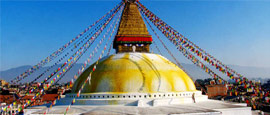Topped by a gilded spire and adorned with paintings of the eyes of Buddha, this famous stupa dates back to circa AD600. Thousands of Tibetan refugees and Buddhist devotees gather every day at sunset to circumnavigate the 36m high (118ft) stupa, lighting thousands of butter lamps on auspicious full- and half-moon evenings. The tower was shaken by the 2015 earthquake but damage was minor and restoration work is underway.
Things to see in Kathmandu
Tourist offices
Address: Pradarshani Marg, Kathmandu, 44617, Nepal
Tel: +977 1 425 6909.
Opening Hours:Sun-Fri 1000-1300 and 1400-1700. www.welcomenepal.com
The main tourist office is a good source of information on the Kathmandu Valley and the Terai. The attached national park office is the place to pay national park entry fees and apply for your Trekkers' Information Management System (TIMS) card.
Constructed by King Pratap Malla in the 17th century, but expanded by his successors in a bewildering combination of styles, the former Royal Palace dominates the southern end of Durbar Square. The stately quarters have been converted into a museum displaying centuries of memorabilia, but most people come to see the elegant courtyards and temples that dot the palace compound. The 2015 earthquake damaged parts of the palace, including the landmark Basantpur Tower, but the museum is expected to reopen once restoration work is complete.
Despite the devastation caused by the 2015 earthquake, Kathmandu’s royal square is still crammed with carved wooden pavilions, dramatic statues and intricately-carved temples, whose soaring roofs and brick plinths mirror the mountains beyond. However, many historic temples were tragically lost, some dating back to the 12th century, and it will take years to restore this UNESCO World Heritage site to its former glory.
East of the centre, just outside the ring road, Kathmandu’s most important Hindu temple is a place of mystery and ritual. Built in the classic step-roofed Newari style, the main temple is closed to non-Hindus, though you can take a peek from the doorway. The surrounding lanes are studded with atmospheric shrines which foreigners are allowed to enter. Below the temple lie Kathmandu’s main funeral ghats, where open-air cremations take place in an air of respectful solemnity beside the sacred Bagmati river.
Across the Bagmati River from Kathmandu, Patan was a rival city-state until the valley was unified in the 18th century by the warlike Prithvi Narayan Shah. As in Kathmandu, Patan's Durbar Square is a rich fantasy of palaces, temples and courtyards, centred on the excellent Patan Museum. Although several temples were toppled by the 2015 earthquake, this collection of stepped temples and ornate palaces is still regarded by many as the crowning glory of Nepali architecture in the Kathmandu Valley.
Crowning a conical hill to the west of Thamel, this revered Buddhist temple soars above the rooftops of Kathmandu. The 2015 earthquake toppled some of the flanking shrines but the main stupa, with its iconic gilded tower decorated with the eyes of Buddha, remained intact. This is one of Kathmandu’s most distinctive landmarks and it offers a spectacular vantage point over the city. Swayambhunath is often called the 'Monkey Temple' because of the wild monkeys that crowd the stone stairway to the shrine.
An oasis of calm amidst the noise and bustle of Thamel, the Garden of Dreams looks like a miniature piece of the gardens at Versailles, transported to Kathmandu. The ponds and pavilions were constructed in the 1920s by Field Marshall Kaiser Shumsher using the proceeds from a successful night of gambling, and were stunningly restored in 2006 using funds from the Austrian government. The 2015 earthquake caused some damage here, but the garden remains one of Kathmandu’s best loved escapes.
The most dramatic of the ancient shrines dotted around the alleyways south of Thamel, the Kathesimbhu stupa sits in a secret courtyard near Thahity Tole. Undamaged in the 2015 earthquake, the monument was constructed in 1650 as a scale model of Swayambhunath. The main stupa is surrounded by a garden of smaller stupas and statues and the surrounding shops sell all sorts of Buddhist paraphernalia, including prayer flags for tying on mountain passes while trekking.
Another earthquake survivor, this ornate 18th-century palace is the official residence of the living goddess Kumari – a young girl worshipped by Nepali Hindus as an incarnation of the goddess Taleju. On special occasions, the child goddess appears before adoring crowds of devotees on the carved wooden balcony. At other times, it’s worth coming to admire the building, constructed in the classic Newari style with leaning eaves and fretwork windows.
West of the centre in the Chhauni district, the National Museum houses a vast collection of ancient artefacts, temple carvings, statues, paintings and medieval weaponry. Although there was some damage in the 2015 earthquake, most of the galleries survived and amongst the treasures are the personal armour and weapons of the kings of Nepal.
Do you have any Feedback about this page?
© 2025 Columbus Travel Media Ltd. All rights reserved. No part of this site may be reproduced without our written permission, click here for information on Columbus Content Solutions.








 You know where
You know where